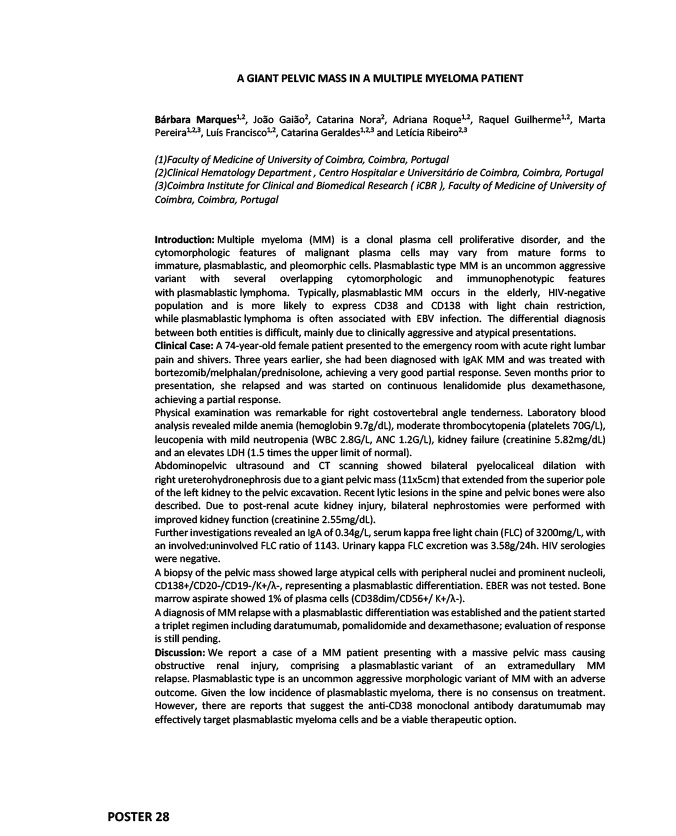
POSTER 28
A GIANT PELVIC MASS IN A MULTIPLE MYELOMA PATIENT
Bárbara Marques1,2, João Gaião2, Catarina Nora2, Adriana Roque1,2, Raquel Guilherme1,2, Marta
Pereira1,2,3, Luís Francisco1,2, Catarina Geraldes1,2,3 and Letícia Ribeiro2,3
(1)Faculty of Medicine of University of Coimbra, Coimbra, Portugal
(2)Clinical Hematology Department , Centro Hospitalar e Universitário de Coimbra, Coimbra, Portugal
(3)Coimbra Institute for Clinical and Biomedical Research ( iCBR ), Faculty of Medicine of University of
Coimbra, Coimbra, Portugal
Introduction: Multiple myeloma (MM) is a clonal plasma cell proliferative disorder, and the
cytomorphologic features of malignant plasma cells may vary from mature forms to
immature, plasmablastic, and pleomorphic cells. Plasmablastic type MM is an uncommon aggressive
variant with several overlapping cytomorphologic and immunophenotypic features
with plasmablastic lymphoma. Typically, plasmablastic MM occurs in the elderly, HIV-negative
population and is more likely to express CD38 and CD138 with light chain restriction,
while plasmablastic lymphoma is often associated with EBV infection. The differential diagnosis
between both entities is difficult, mainly due to clinically aggressive and atypical presentations.
Clinical Case: A 74-year-old female patient presented to the emergency room with acute right lumbar
pain and shivers. Three years earlier, she had been diagnosed with IgAK MM and was treated with
bortezomib/melphalan/prednisolone, achieving a very good partial response. Seven months prior to
presentation, she relapsed and was started on continuous lenalidomide plus dexamethasone,
achieving a partial response.
Physical examination was remarkable for right costovertebral angle tenderness. Laboratory blood
analysis revealed milde anemia (hemoglobin 9.7g/dL), moderate thrombocytopenia (platelets 70G/L),
leucopenia with mild neutropenia (WBC 2.8G/L, ANC 1.2G/L), kidney failure (creatinine 5.82mg/dL)
and an elevates LDH (1.5 times the upper limit of normal).
Abdominopelvic ultrasound and CT scanning showed bilateral pyelocaliceal dilation with
right ureterohydronephrosis due to a giant pelvic mass (11x5cm) that extended from the superior pole
of the left kidney to the pelvic excavation. Recent lytic lesions in the spine and pelvic bones were also
described. Due to post-renal acute kidney injury, bilateral nephrostomies were performed with
improved kidney function (creatinine 2.55mg/dL).
Further investigations revealed an IgA of 0.34g/L, serum kappa free light chain (FLC) of 3200mg/L, with
an involved:uninvolved FLC ratio of 1143. Urinary kappa FLC excretion was 3.58g/24h. HIV serologies
were negative.
A biopsy of the pelvic mass showed large atypical cells with peripheral nuclei and prominent nucleoli,
CD138+/CD20-/CD19-/K+/λ-, representing a plasmablastic differentiation. EBER was not tested. Bone
marrow aspirate showed 1% of plasma cells (CD38dim/CD56+/ K+/λ-).
A diagnosis of MM relapse with a plasmablastic differentiation was established and the patient started
a triplet regimen including daratumumab, pomalidomide and dexamethasone; evaluation of response
is still pending.
Discussion: We report a case of a MM patient presenting with a massive pelvic mass causing
obstructive renal injury, comprising a plasmablastic variant of an extramedullary MM
relapse. Plasmablastic type is an uncommon aggressive morphologic variant of MM with an adverse
outcome. Given the low incidence of plasmablastic myeloma, there is no consensus on treatment.
However, there are reports that suggest the anti-CD38 monoclonal antibody daratumumab may
effectively target plasmablastic myeloma cells and be a viable therapeutic option.